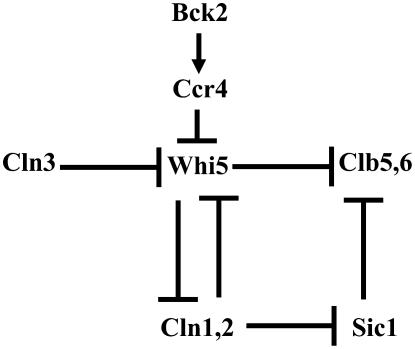Figure 8.—
A working model. Cln3 and Bck2 promote cell cycle progression via different cell-size-dependent mechanisms. When cells attain the minimum cell size requirement, Cln3-Cdc28 kinase complexes phosphorylate Whi5 to drive it out of the nucleus. In addition, also via a size-dependent mechanism, Bck2 promotes cell cycle progression by stimulating the ability of Ccr4 to destabilize WHI5 mRNAs. This provides cells with a Cln3-independent means for inhibiting Whi5 activity. This model explains how ccr4Δ cells are abnormally large and why Bck2 is not functional in ccr4Δ cells. Moreover, because cln3Δccr4Δ cells are inviable, this model indicates that Bck2 is dependent upon Ccr4 to inhibit Whi5 in the absence of Cln3. This inference is supported by the observations that, like bck2Δswi6Δ cells, ccr4Δswi6Δ cells are inviable. Finally, the finding that cln1Δcln2Δccr4Δ cells, like cln1Δcln2clb5Δclb6Δ cells, are inviable suggests that, in the absence of Cln1 and Cln2, Cln3's ability to induce CLB5 and CLB6 expression is dependent upon Ccr4.

